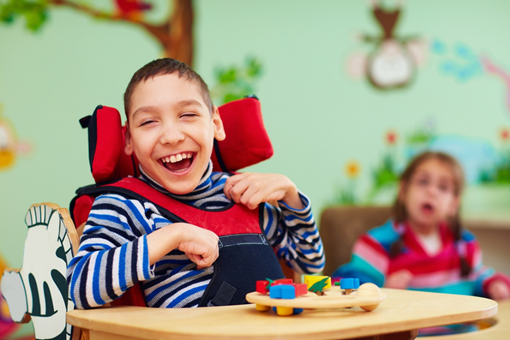
Classifying and Defining Autism Spectrum Disorder: A Guide for Caregivers
Until 2013, autism was classified under a handful of labels, such as Asperger’s Syndrome and Pervasive Developmental Disorder-Not Otherwise Specified, which are no longer commonly in use. It was the publication of the DSM-5-TR, the most recent edition of the diagnostic handbook trusted by health professionals around the world, that merged these various diagnoses together into what is now known as Autism Spectrum Disorder (ASD).
Although the exact cause of ASD isn’t known, people with ASD often have trouble with communication and behavior because their brains work differently. This can mean things like finding it hard to make eye contact or understand social cues, and sometimes needing help with everyday tasks.
If your loved one has been diagnosed with ASD, read on to become familiar with the terms you’ll come across while navigating the resources available to you, or while seeking to qualify for certain benefits.
What Kind of Disability Is ASD?
ASD is defined by the medical community as a developmental disability that causes social and behavioral challenges which can often impact learning. However, it is not a learning disability.
Dyslexia and Attention Deficit/Hyperactivity Disorder (ADHD) are types of learning disabilities that mostly affect reading, writing, math, or other school skills. Autism, however, is different because it mainly affects how people communicate, socialize, and sometimes how they process senses.
Being on the autism spectrum does affect learning, sometimes in ways that resemble learning disabilities, and children with ASD are often eligible for special education services under the Individuals with Disabilities Act (IDEA). It’s also possible for someone to have a learning disability in addition to autism. An estimated 30 to 80% of children with autism also meet the criteria for ADHD and, conversely, 20 to 50% of children with ADHD for autism.
Diagnostic Criteria for ASD
Health experts in the U.S. and worldwide use the DSM-5-TR to diagnose ASD. To start the diagnosis, they look for ongoing challenges in certain areas:
- Social-emotional reciprocity, referring to the ability to approach and respond to others in social interactions.
- Deficits in nonverbal communicative behaviors, ranging from too much or too little eye contact to a total absence of facial expressions and gestures.
- Deficits in developing, maintaining, and understanding relationships, such as having trouble adjusting behaviors to fit the social setting or struggling to make friends.
In addition to this, a person must display at least two out of four types of restrictive, repetitive behaviors to be diagnosed with autism:
- Repetitive motor movements, use of objects, or speech.
- Strict adherence to routines, with extreme distress at small changes.
- Highly restricted interests which are intensely focused upon.
- Hyper- or hypo-reactivity to sensory input.
ASD might be diagnosed for young children during developmental screenings conducted at the doctor’s office, school, or other places in the community. It can sometimes be detected in infants at 18 months or younger, but usually by the time a child is 2 years old, a specialist should be able to provide a reliable diagnosis.
Early intervention for autism can really make a difference in how well a child navigates social situations, helping them become more confident as they grow. If a doctor sees any signs of autism during check-ups, they might send the child to someone who can help, like an early intervention specialist if they’re under three years old, or a special education program if they’re older.
Autism Disability Benefits: Care and Coverage
The U.S. Social Security Administration (SSA) recognizes ASD as a potentially disabling condition that may qualify children or adults for social security benefits. To identify who is eligible, the SSA has a Listing of Impairments that can make someone eligible for these benefits.
To qualify for autism disability benefits, an individual must have medically documented findings of the following:
- Qualitative deficits in the development of reciprocal social interaction
- Qualitative deficits in verbal/nonverbal communication and in imaginative activity
- Markedly restricted range of activities and interests
Additionally, for children to be diagnosed with ASD and qualify for benefits, they must also demonstrate a certain level of impairment through specific behaviors:
- For infants and toddlers aged 1-3, they must demonstrate no more than one-half the age-appropriate level of functioning in one area, or have no more than two-thirds the age-appropriate level of functioning in two or more of the following areas:
- Gross or fine motor development
- Cognitive/communicative function
- Social function
- For children aged 3-18, they must demonstrate a noticeable impairment in two or more of these categories:
- Cognitive/communicative function
- Social functioning
- Personal functioning
- Maintaining concentration, persistence, or pace
People with autism could potentially qualify for two disability programs: Supplemental Security Income (SSI) and Social Security Disability Insurance (SSDI). SSDI is typically only available to adult, disabled individuals who meet the medical and work history requirements. SSI is open to people of all ages with disabilities if they meet the medical and financial limitation requirements. You can learn more about each program and how to apply on the SSA website.
Despite national assistance programs and established criteria for an autism diagnosis, where a person lives has been shown to have a significant impact on their cost of care, coverage options, and the educational programs they have access to. Additionally, the programs and assistance available to the caregivers of people with autism can also vary state-by-state.
Familiarizing yourself with the terms and criteria surrounding autism enables you to access the available support services and provide your loved one with the best possible care. And it’s important to remember that you are not alone in your caregiving journey and in navigating your loved one’s disability. We at Careforth are here to help you feel supported at every turn.
Visit the How We Help page on our site to learn more about how Careforth supports caregivers, or contact uscontact us for more information.
More insights like this:
-

5 Great Holiday Nutritional Tips for Loved Ones with Complicated Medical Conditions
Read more: 5 Great Holiday Nutritional Tips for Loved Ones with Complicated Medical ConditionsFor many of us, the holiday season is a time of celebration, reconnecting with friends and family, and eating lots of delicious food. But for people with medical conditions that place restrictions on what they’re able to eat, the holidays can be a difficult time to stay on track.
-

Caring for Someone with End-Stage COPD? Here’s What You Should Know
Read more: Caring for Someone with End-Stage COPD? Here’s What You Should KnowChronic obstructive pulmonary disease (COPD) is a progressive condition for which a cure has not yet been discovered. It inflames a person’s lungs in a way that can obstruct the airway with swelling and the production of mucus. Emphysema and chronic bronchitis are the two lung conditions that cause COPD, and they tend…
-

Caring for a Child with Disabilities? Here are Your Financial Assistance Options
Read more: Caring for a Child with Disabilities? Here are Your Financial Assistance OptionsWhen your child has disabilities that require 24/7 care, caring for them at home might be the option that best suits their needs, with the added benefit of keeping them close to you every day. But home care also comes with emotional and financial obstacles that can lead to caregiver burnout or make…